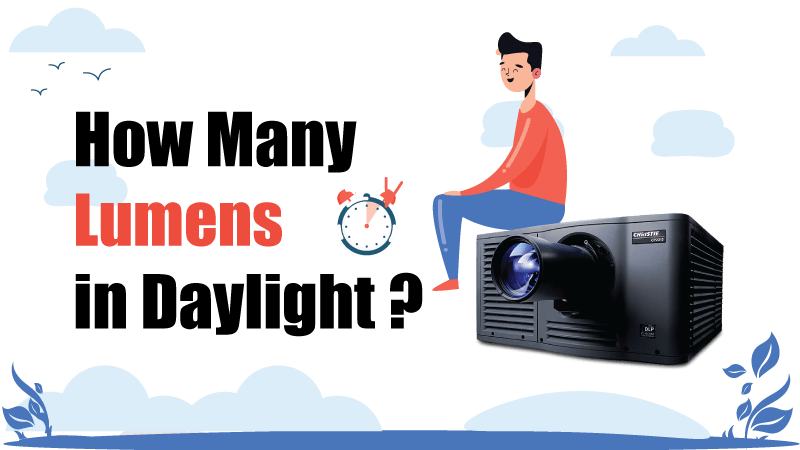So the question, How many lumens do you need to project in daylight? You know, Having the correct number of lumens prevents faded images. On an average 2500, and above lumen count is adequate for daylight projection, but considering certain factors.

What is a lumen?
Lumen is the measure of brightness. The higher the lumen in the projector, the brighter the projector. In daylight, the ambient light intensity is high. It requires a high lux to match the light intensity.
What are the crucial factors influencing lumen for projectors in daylight?
The number of lumen for daylight projection depends on different situations. However, two are the most common ones: Environment and Natural conditions.
Environment: How do the surroundings affect luminosity?
Your environment has a lot to do with the number of lumens in the projector. Some areas are well illuminated, while some are not. A room with many windows has a good amount of light intensity, so it takes more lumen to produce a clear and unfaded image, while a room with less lighting would need less lumen to do the same.
Let’s understand the impact according to different areas.
Indoors: How do different indoor objects affect the equation of lumens?
A flashlight will help illustrate this concept. Put on a torchlight with enough natural light, then the light will be invisible, not even noticed, but if you shut the windows and flash the light again, it could have an impact because it reduces the intensity of light entering the room. That is why the intensity of light entering the rooms and the lumen from the projector must be equal.
Lightened rooms: What about some other well-illuminated places?
Most times, Classrooms, supermarkets, conference rooms, auditoriums, and places of worship are well illuminated, so there’s a need for a high intensity of light for the projector to match lights coming from its surroundings. That’s why there’s a need for at least 2500 ANSI lumen and above.
Cinematic rooms: Do Home cinemas also have an impact?
Sometimes commercial and home cinema, some conference rooms, and presentation rooms are original-built cinematic style. They can have blacked or completely black; it doesn’t matter if it’s daylight or not because it controls the light intensity. You don’t need so many lumens for projection in this type of room, be it day or night. A projector of 1000 to 1500 ANSI lumen is adequate to give you a sharp image if it’s a conference room or your home cinema.
Outdoor: Outdoor has always been a task for any projector
Unlike indoor, where you can control the light in daylight, you have very little control over outdoor lighting. Light comes from every corner, so there’s a need for a projector with a high amount of lumen, one that’s bright enough to match the amount of light intensity to produce a sharp image.
Natural light condition: Are different weather conditions also involved?
The weather conditions affect the brightness of the day. Sometimes the day is so bright or dull. The natural conditions imply that the light intensity during the day can be high or low, thereby influencing the display of light from the projector like the flashlight illustration we used earlier. Let’s discuss some of the conditions that nature can invite.
Direct sunlight: The sun, our sun, has a lot to speak—Sorry, No possibility.
When the sun is at its peak, and the projection is happening under direct sunlight, then you’re bound to use a projector with a very high density. Depending on how bright the sun is, 32,000 lux and above is adequate. Any projector with a lumen of 120000 lux is best for direct sunlight but does not exist currently.
Ambient daylight: There are some possibilities for Ambient light
Ambient daylight is not as bright as direct sunlight, so 10000 to 25,000 lux is adequate.
Overcast: Not a big thing for any projector
During overcast, clouds cover the sky, which means reduced sunlight. As a result of the limited light from the sun, light rays can easily be visible. A 1000 ANSI lumen is adequate.
The Solution: Five things you can do to improve projection during the day
People often make the mistakes of any surface for projection without realizing how much it hurts what’s displayed. They use a whiteboard, plane wall, Etc., thereby making their image appear faded.
To make a good display, use dark screens. You can use the reflective screen designed for this purpose or attach a black fabric to the surfaces of the projection.
When it is on a black platform, the darker the black and the whiter the white gives you an excellent display, so you can see that projection on an ordinary wall is not enough, especially during daylight.
#1. Use reflective screens: The role of ALR screens. It would help if you had it.
Reflective screens are specially designed screens used in projection. They fend off excessive light from the environment. It is then suitable for light from the projector to be uninterrupted by surrounding light and create a sharper image.
Related: ALR Screens Guide
#2. Size of screen: An ideal screen size can make a huge difference
Have you ever noticed a projection falling outside the screen? It’s not cool at all. Most of the information that falls outside the screen is lost because that area will appear faded, so you must measure the screen size. You can use project sizing calculators to help yourself.
Related: A guide to projector screen size
#3. Calculating the lumen: Don’t forget the number of lumens
Knowing how to calculate lumen will help you with the amount of light you need from a projector to match the surrounding light. The result gives you heads-up on what choice of lumen is best for the projection.
Here’s the formula: Know the required lumens.
Lumens = ft-L x Square-feet / Gain
Where square feet is the screen area in square feet and gain is the screen’s gain.
To find the needed lumens, you will need to multiply your room square footage by your room’s foot-candle need.
Let’s me show this practically,
A 200 square foot business conference room, which needs 20-40 foot candles, will need 3,000-6,000 lumens. Then calculating for 100 square foot reception, which requires 30-40 foot-candles, will need 5,000-6,000 lumens.
Related: The Definitive Guide To Projector Lumens
#4. Throw distance: Basic but very effective in projection
It’s worth noting that the distance between the projector and the screen (throw distance) affects the image projected. The shorter the length, the brighter the image and vice versa.
The formula for calculating throw ratio:
Ratio x Width = distance
Related: All About Projector Throw Distance
#5. Contrast ratio: The last thing you can do to your projector
The contrast ratio is the measurement of brightness between the brightest color and the darkest color. It is just as important as the number of lumens present in a projector. You must consider it because it helps the visual be more detailed. If the contrast ratio is poor, you’re bound to a pixelated image displayed.
Generally, you’ll need higher contrast in an area that’s dim but not super dark. The projector must have a high contrast ratio when used during the day. So consider that when looking at a projector.
The Golden Tip: Don’t forget the basics at any cost
It’s important to note that different elements come together to give a perfect projection. Therefore, it’s crucial to consider the contrast ratio of a projector (Contrast ratio give the image the displayed more detail and better quality) as it works hand in hand with lumen, also the distance between the projector and screen (The shorter the length, the brighter the image).
Conclusion: What else do I have to say?
Finally, the projector pack contains information about the lumen, contrast, and other helpful information, which would guide or inform you about the projector. But if you’re hiring, no worries, you can ask the hirer. I bet they would have all the information you need.
Projectors are great tools for presentations, so you must pay attention to getting the one that suits your environment. Lumen and contrast are essential elements in achieving a popping image, so always look out for these when buying the best projector for the daytime.

